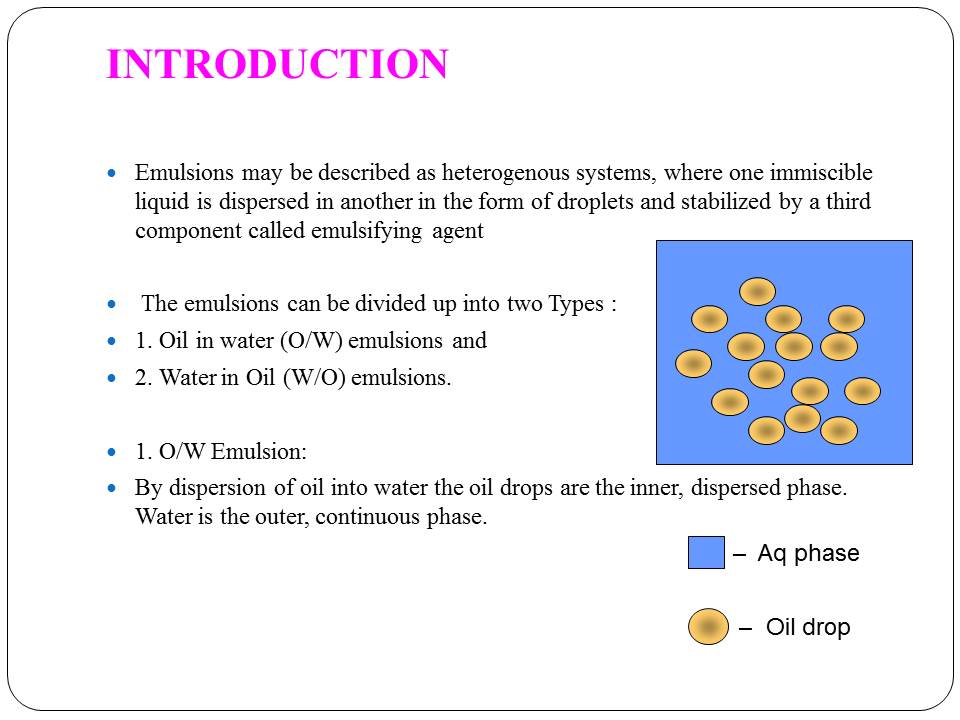Contents of the powerpoint on Multiple Emulsions include:
INTRODUCTION
TYPES OF MULTIPLE EMULSIONS
PREPARATION OF MULTIPLE EMULSIONS
IN VITRO CHARACTERIZATION
STABILITY OF MULTIPLE EMULSIONS
APPLICATIONS
CONCLUSION
REFERENCES
Download the powerpoint by liking us on Facebook
[like-gate][/like-gate]
[button url=”http://pharmawiki.in/wp-content/uploads/2014/01/Multiple-Emulsions.pptx” style=”glass” background=”#1782f9″ color=”#ffffff” size=”4″ center=”yes” icon=”icon: download”]Download PPT here[/button]
You can also download the PDF onMultiple Emulsions by clicking here
[button url=”http://pharmawiki.in/wp-content/uploads/2014/01/Multiple-Emulsions-rasterized.pdf” style=”glass” background=”#1782f9″ color=”#ffffff” size=”4″ center=”yes” icon=”icon: download”]Download PDF here[/button]
“Unlocking the Potential of Multiple Emulsions: Types, Preparation, Characterization, Stability, and Applications”
Introduction to Multiple Emulsions
Multiple emulsions, a fascinating class of colloidal systems, offer unique advantages in various industries, from pharmaceuticals to cosmetics and food technology. These complex emulsions, often referred to as “W/O/W” (water-in-oil-in-water), are engineered structures comprising multiple layers of aqueous and oil phases. In this comprehensive exploration, we delve into the world of multiple emulsions, covering their types, preparation methods, in vitro characterization, stability considerations, and versatile applications.
Types of Multiple Emulsions
Multiple emulsions come in several types, each tailored to specific applications and encapsulation requirements. The primary types include:
W/O/W Multiple Emulsions: In this classic configuration, water droplets are dispersed within oil, which is subsequently enveloped by an outer water phase. This type is ideal for encapsulating hydrophilic compounds while protecting them from the external environment.
O/W/O Multiple Emulsions: In the reverse scenario, oil droplets are surrounded by water, forming a water-in-oil-in-water emulsion. This type is suitable for entrapping lipophilic substances within an aqueous medium.
S/O/W and S/W/O Multiple Emulsions: These specialty emulsions incorporate a solid phase (S) in addition to the aqueous and oil phases, expanding their applications in controlled release and encapsulation.
Preparation of Multiple Emulsions
Multiple emulsions can be prepared using various techniques, offering control over their composition and structure:
Two-Step Emulsification: This method involves creating a primary emulsion, typically a water-in-oil (W/O) emulsion, followed by the addition of an outer aqueous phase to form the final water-in-oil-in-water (W/O/W) multiple emulsion.
Phase Inversion Methods: These techniques induce phase inversion between W/O and O/W emulsions by altering factors like temperature or the addition of co-surfactants. This approach provides versatility in emulsion design.
In Vitro Characterization of Multiple Emulsions
Characterization is crucial for understanding the properties and behavior of multiple emulsions. In vitro characterization methods include:
Microscopy: Optical and electron microscopy enable visualizing the internal structure, including droplet size and distribution.
Particle Size Analysis: Techniques like dynamic light scattering (DLS) assess droplet size distribution, influencing stability and performance.
Rheology: Measuring viscosity and flow behavior helps determine the emulsion’s physical properties.
Zeta Potential: Assessing surface charge aids in predicting stability, as droplets with varying charges may repel or attract each other.
Stability of Multiple Emulsions
Stability is a critical aspect of multiple emulsions due to their intricate structure. Factors affecting stability include:
Ostwald Ripening: The growth of larger droplets at the expense of smaller ones over time, potentially causing instability.
Flocculation and Creaming: Aggregation and vertical migration of droplets can lead to phase separation.
Coalescence: The merging of adjacent droplets may result in the formation of larger droplets and eventual phase separation.
Applications of Multiple Emulsions
Multiple emulsions find diverse applications across industries, including:
Pharmaceuticals: Controlled drug delivery systems, enhancing drug solubility, and targeted therapies.
Cosmetics: Encapsulation of active ingredients, improving skin care and cosmetics products.
Food Technology: Enhanced flavor and aroma delivery, controlled release of nutrients, and improved food product quality.
Biotechnology: Encapsulation of enzymes and biologically active compounds for various applications.
Agriculture: Controlled release of fertilizers and pesticides for improved crop yield and sustainability.
Environmental Remediation: Delivery of remediation agents for cleaning up contaminated sites.
In summary, multiple emulsions are versatile systems with a wide range of applications, underpinned by their unique structure and properties. Understanding their types, preparation methods, characterization techniques, stability considerations, and diverse applications is crucial for harnessing their potential across industries.

